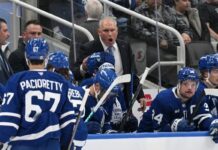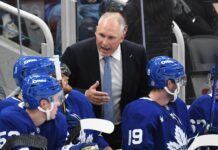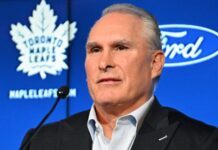Celebrating a decade of squandered potential and faded dreams, the draft of 1999 turned out shallower than an infant—s paddling pool, yet despite being regarded as an acrimonious footnote in league history the draft of —99 also served as an unlikely backdrop to one of the most meticulously engineered pre-draft coups ever.
Having only entered the Vancouver office six days prior to the draft of 1998, GM Brian Burke was looking to make a splash in his first hands-on draft since selecting Chris Pronger second overall in 1993, months before leaving the Hartford Whalers to become NHL senior vice president .
Having inherited a team on the skids, the season prior to the Boston draft was a trying affair. With Russian superstar Pavel Bure holding out on contract talks, Vancouver failed to reach the 200 goal plateau for the first time in their 28 year history whilst simultaneously enduring their worst winning percentage since —72-—73. Managing to salvage some futureproof talent from the train wreck, Burke traded the wantaway Russian for prospective franchise D-Man Ed Jovanovski.
Subsequently anchoring the defense, Burke set his sights on replacing the 50 goal scoring Bure with the third overall selection that came as a reward for the Canucks abject season.
Theoretically the plan was sound, at least in the long term, the draft was considered extremely well stocked at the front end with big Czech centerman Patrik Stefan vying for first overall with Swedish left winger Daniel Sedin and Pavel Brendl who had tallied an impressive 134 points in just 68 WHL games.
With so little to choose between the three, the consensus tended toward Stefan or Brendl as they appeared the most NHL ready, not just on talent but preparation and commitment.
Meanwhile Daniel Sedin—s stock had slumped in the months leading up to the draft. Word was the Ornskoldsvik native would not make the big league jump without his twin brother Henrik with whom he had built a scintillating, almost telepathic rapport throughout childhood and within the professional MoDo system. While the two were both first round locks, unsurprisingly granted their respective 45 and 34 point seasons in the senior Elitserien, chances any team would be willing to give up enough to secure both seemed slim, especially as franchises valued the goal scoring side of Daniel—s game higher than the playmaking work of his brother.
With uncertainty surrounding the twins Brian Burke was concocting a plan, to double up and bring two NHL ready forwards with chemistry to Vancouver. The problem: one first round selection was sure to miss the boat on Henrik while selecting third couldn—t guarantee Daniel despite concerns. As a comparable apprentice in an old hands game, Burke was going to have to pull a major deal with a franchise sorely lacking trade leverage.
Of course pulling any kind of trade is dependant on circumstances, a perfect storm of factors that have to come together to make a deal work for all concerned and never is that more prevalent than trying to scale a draft. Like family trees, trades can be traced in chronology, to a retirement or a draft, even to a time when players changed hands for cash. For every move that is made in the present, several were made in the past to bring those pieces to the board. If you were to throw draft picks into the genealogy the web would become extraordinarily complex, like a microcosmic six degrees of separation. For the sake of keeping a long story short, the catalyst for the series of trades that proffered Brian Burke the second and third overall selection in June 1999 can be traced back to the 23rd of March that same year.
Cited as one of the all-time greatest deadline deals, the trade of 37 year old hometown hero Chris Chelios from Chicago to arch rivals Detroit for 24 year old up and comer Anders Eriksson seemed to provoke more intercity hatred than anything else. Foregoing the historical relevance and subsequent longevity of Chelios, the crucial element of the trade was the late first round selection that was afforded to the Chicago Blackhawks. Now stocked with two first day selections the Blackhawks had the choice to build from the draft or to bait an experienced player using their wealth of draft board space. On the eve of draft day, they opted for the latter.
Recognizing Eriksson couldn—t come close to replacing Chelios within the Chicago lineup then GM Bob Murray was looking for a young NHL ready defensive star with whom he could restructure the blueline. Offering up Bryan McCabe, a 24 year old who had served as captain for one year on Long Island and had carved a niche as a useful top four defender, Brian Burke loaded the deal with a first round selection in 2000. Suitably pleased, Murray accepted the trade and would later add another D-man in Steve McCarthy with the selection traded by Detroit.
With McCabe offloaded, Burke now found himself in possession of selections three and four but still burdened by Daniel Sedin—s potential to go to Tampa or Atlanta who owned the selections above.
Much like a chess player plans moves ahead; Burke had already got the ball rolling with then Tampa GM Rick Dudley before Chicago coughed up their fourth overall.
Tapping an already wound up Dudley for the duration of the Media Day, Burke was desperate to pry the first overall selection away from an organization that had suffered two dreadful seasons in the basement. Speaking some years after the fact, Burke recalled the moment he broke the Tampa GM—s resistance when offering him a pick that had yet to register on the board.
I had some difficult and profane conversations with him [Dudley] that night, I told him: ‘Nobody is leaving with these kids except me.’ And finally I told him we had two of the top four picks [third and fourth overall] and he said that [trade] hadn’t come across yet¦ I said it was registered a couple of hours ago.”
Sending the fourth overall to Tampa alongside a couple of third round picks offered the rock bottom Lightning a chance to draft high and deep while Burke held picks one and three. The Sedin game now appeared complete but Burke—s master plan remained unfinished. There was little chance the Thrashers were going to draft Henrik solely to spite Burke but with the first overall selection the Canucks GM saw an opportunity to grease the pole and butter up a newfound rival.
Fronted by a former Stanley Cup winning assistant GM Don Waddell, the expansion Atlanta Thrashers were looking to make some noise in their inaugural draft 19 years after the Flames bolted to Calgary. Initially holding the number two pick and fawning after Patrik Stefan, Burke allowed Waddell the limelight stipulating the Thrashers took Stefan, in doing so Burke established a relationship with the Atlanta GM with whom he would work a number of times regarding the US national team.
With the final, tamest trade in place, Burke held picks two and three, the very picks he would select Daniel and Henrik respectively. While the world would have to wait until the final selection of round seven to see a true superstar immerge when Henrik Zetterberg was taken 210th there is no denying the impact the Sedin—s have had on the Vancouver Canucks in the ensuing decade. For all the ups and downs under which the twins have ebbed and flowed, the Sedin—s have developed into a duo capable of over 150 points a season; a double act few teams could follow.
This however is no parable about why the Sedin—s should be reunited with Burke; this is a statement of precedents about an architect who knows what he wants and knows how to get it. A statement more than prevalent in the present tense.
Ten years removed from the Swedish twins, Burke has matured into a cup winning executive who frequently and masochistically puts his neck on the line. Now entering the draft of 2009 as GM of the Toronto Maple Leafs, Burke has been an outspoken advocate of ascending the draft board with John Tavares very much in his sights.
While many see it as a Burke smoke screen there are similar conditions to those a decade ago. With rumor suggesting Tavares dissatisfaction with his prospective Long Island destination there is a palpable sense of insecurity within the Islanders camp that is farther reaching then the dilapidated surrounds of the Nassau Memorial. Furthermore, Burke has a high selection in his pocket, a roster full of limited but still serviceable trade bait and the added advantage of only one want¦ a higher pick.
Of course as with any perfect storm there are those conditions that have changed. No doubt with all the blind fortitude entering the draft of —99 the frequency with which the top picks moved indicated a certain sense of uncertainty within the ranks of GM—s league wide. By comparison the draft of 2009 is being heralded the very pinnacle of the current youth cycle in Canada, America and Sweden.
Meanwhile the changing face of the game post lockout has seen an ever increasing batch of draftees fast tracked to the big leagues, part salary cap limited part modern day youth conditioning. With the Salary cap likely to slip this year or next, chances any team is going to swap cheap youth for expensive so-so experience in the form of Kaberle or Kubina is far less likely than the days a Red Wings side would trade a 24 year old for a 37 year old.
Finally the economic downturn has created an air of panic in cities unable to win. With the draft offering organizations the chance to hype fans into seats with instantaneous zeal, the kind of package required to pull a Tavares or a Hedman from a struggling club like the Islanders or a Sunbelt city like Tampa with notoriously fickle support would almost certainly be detrimental to the Leafs.
With number three slot owners Colorado coveting a Joe Sakic replacement in the form of Matt Duchene, logic dictates that any move north on the draft board is capped at number four. Duplicitously, rising three places on the board would likely proffer anyone of Brayden Schenn, Evander Kane, Jared Cowen or Magnus Paajarvi-Svensson. With one of the latter two bound to be drafted seventh or lower, the former would offer Burke options. With Brayden Schenn, Burke would once again bring two brothers into the fold as youthful franchise cornerstones, albeit a defensive defenseman and an archetypal Burke styled two way centerman, while Kane is a fast, rough cut forward with great sense and bottomless potential.
It may be a long time in the new NHL before any GM can orchestrate the kind of ballsy move Burke pulled in 1999 but if any man can imitate the green Canucks GM a decade past then it will be Burke himself. Sure moving three spots up won—t set the world on fire like the trades that secured the Sedin—s, but it would certainly demonstrate an administration headed in the right direction in Toronto. With the best part of six days until D-Day, never underestimate Burke—s ability to twist and manipulate.
































